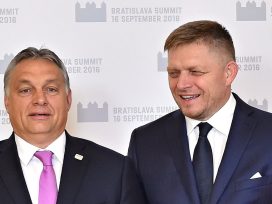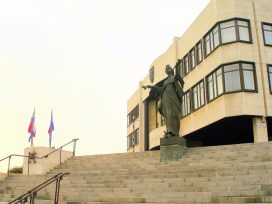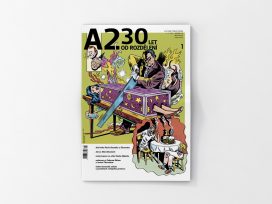For the past few months a neighbour has been leaving the tabloid Novy cas by my front door. I guess this is his way of paying me back for the eight years I put the next day’s issue of Slovakia’s largest-circulation serious daily SME, of which I was editor at the time, through his letter box.
Today, I learned from the tabloid that our populist leftwing prime minister Robert Fico, who had won the hearts of the poorest voters, wears a 20 000 euro watch and that his coalition partner, the nationalist populist Ján Slota, has several luxury cars in his garage and loves to fly his private plane whenever he is not too drunk. I am relieved to read news of this kind and see it as a sign that press freedom in Slovakia is not as restricted as it sometimes seems.
Nevertheless, the fact is that media freedom in Slovakia today – 20 years after the communist regime fell in 1989 – is again under threat. As a result of a cartel that the justice system has formed with the government, and with the help of corrupt or cowardly judges, politicians have been able to win enormous sums of money as compensation in lawsuits they have pursued in their capacity as “private citizens”. Slovak judges have effectively ignored European tradition and the opinion of the European Court of Human Rights that recommends that politicians, in their capacity as public officials, should enjoy less protection from media criticism than private citizens.
One of the most successful litigators is Stefan Harabin, who stepped down as Minister of Justice in June 2009 to become President of Slovakia’s Supreme Court. His position effectively gives him control over the entire justice system, which means that few judges dare stand up to him. He has succeeded in extracting a total of almost 100 000 euros as compensation from the media. Most recently, SME was ordered to pay him 33 000 euros. The paper carried a story dating back to 1985 when Harabin, then already a Supreme Court judge, gave a legal opinion in the trial of a Catholic priest. Based on Harabin’s expert opinion the communist regime sent the priest to prison for two years for performing mass in private. After researching the case, SME claimed that it was Harabin himself who had sentenced the priest to a term of imprisonment, rather than having been merely the author of the expert opinion on which the judgement was based. For this minor inaccuracy the daily was forced to pay the inordinate sum above.
The purpose of these huge compensations awarded by the courts to politicians is to intimidate the media and, in some cases, to go so far as to destroy them financially. The very principle of “compensation” is absurd. For example, Harabin claimed in court that the article SME published in 2005 damaged his reputation, yet this “damage” has not prevented him from being appointed Minister of Justice and, later, President of the Supreme Court.
Fico and his coalition partner Ján Slota have also been successful in suing the media. Fico has won several lawsuits and been awarded tens of thousands of euros in compensation. In some cases, the lawsuits concerned quite ludicrous issues. In 2007, for instance, the economic weekly Trend sported a cover picture of Fico with the caption “The thief of future pensions”. This reflected the prime minister’s harsh criticism of his predecessor’s pension reform introducing private pension savings. Fico publicly denounced the reform and threatened to abolish it, hence the caption. However, the court concluded that Trend had slandered him and ordered it to pay him 8000 euros and issue an apology.
Ján Slota, in turn, won a lawsuit against the tabloid Novy cas which carried a story describing how, as a young man in 1970, he had been detained with a friend during an attempted escape from Czechoslovakia. The story was based on communist archives that are now accessible to the public. Slota’s friend later joined a criminal gang. Admittedly, the tabloid did spice up the caption somewhat, creating the impression that it was Slota rather than his friend who had become a criminal, yet the court’s award of 20 000 euros compensation was out of all proportion to the offence.
There are dozens of similar examples. This is obviously a deliberate attempt to restrict media freedom and to dampen media criticism of the government. It is also unique in central Europe. In the neighbouring Czech Republic, politicians seldom win lawsuits against the media and the compensation – if any – is more or less symbolic. This is because the Czech Constitutional Court has ruled on several occasions that in the interest of free expression politicians must at times endure media criticism, however harsh.
In many ways, Slovakia represents a laboratory of freedom in central Europe, at the confluence of the authoritarian East and the liberal West. In the 1990s, journalists fought hard to win their freedom and it seemed at the time that their battle was won for good.
The then prime minister, the authoritarian Vladimír Meciar, was determined to silence independent print media in various ways. In 1995, the printing presses – then all still owned by the state – suddenly refused to print the opposition daily SME. The paper responded by buying its own printing press and, in the process, ironically, achieved real independence. Meciar then determined to introduce a dramatic rise in VAT on printed papers in order to weaken the press economically. However, the next day the Slovak dailies closed ranks and all appeared with a blank front page. They kept each other informed of instances of journalists being intimidated by the secret services (one journalist had his car blown up outside his home, another was followed in the street and many others were quite openly bugged.) The only result of Meciar’s efforts was to unite the media in a strong opposition front that later helped the political opposition to win the 1998 general election.
Having triumphed over the authoritarian Meciar, freedom of the press seemed to be in excellent shape for a while. Surely the politicians, whom the media had helped to gain power, would lend it their full support? Alas, the enforced love affair between politicians and journalists proved to be short-lived. The new political line-up soon succumbed to the lure of corruption, which, in turn, attracted criticism from the media. The gap between the two sides continued to grow until it turned out that the new government had ordered the secret service to bug journalists of SME. The widespread scandal that followed led to a bitter conflict between the media and the then Prime Minister Mikulás Dzurinda, who took two leading dailies, Pravda and SME, to court demanding compensation in excess of 150 000 euros – for opinion pieces! The case is still going through the courts.
Nevertheless, during this period, which lasted until 2006, relations between the powers that be and the media were closer to western liberal standards than ever. Even though politicians tried to exert influence over journalists (successfully in many cases), and even though they complained about editors to their publishers, refused to give interviews or answer difficult questions, none of this differed greatly from the common practice in central Europe. Despite bitter disputes, there was tacit agreement on fundamental notions such as Slovakia’s entry into the EU and Nato, and the need for economic reforms. When the government dramatically raised VAT on newspapers even higher than Meciar had intended in his day, recognizing that the decision made economic sense, neither journalists nor publishers raised their voices in protest.
After 2006, following Fico’s election victory, the situation again deteriorated, eventually descending into open warfare between the Prime Minister and the media. Fico has repeatedly referred to journalists as hyenas and whores, accusing them of working for the opposition and of being corrupt, and journalists have paid him back in the same coin.
The inclusion in the media legislation introduced by the government in March 2008 of an article on the “right to reply” led to protests by international journalist organizations. The article obliges the media to publish the responses of individuals who feel personally offended. Fico claimed that the purpose of the law was the protection of ordinary citizens who needed an instrument against the slanderous media; but, as it soon turned out, the only “offended citizens” to make use of the new law were politicians and entrepreneurs. Once again, just as under Meciar, the Slovak media formed a united front. On the day the bill was going through parliament, all Slovak newspapers appeared with a title page that was blank apart from a brief protest against the bill. Any anxiety that newspapers would be inundated by hundreds of responses from “offended citizens” making use of their right to reply has so far proved groundless. The law has been in force for over a year yet the number of responses published as a result has not exceeded a few dozen. The main reason is that the media hired top lawyers who discovered a number of errors in the legislation that enabled them to reject the majority of requests for a response. The question is what will happen once some of these cases make it to court. The attitude of the courts to the media has been outlined above.
A love affair with the Right
The battle for the freedom of the press led by the media and the politicians is evidently not over in Slovakia yet it would be an exaggeration to claim that Slovakia is “unfree”. In spite of all attempts on the politicians’ part to drive critical media into a corner, it is the newspapers that harry the politicians into a corner on a daily basis, exposing their corruption and lies, dressing them down and mocking them, often with justification.
Nevertheless, it is not only external pressures that threaten the independence of the Slovak media. While their running battle with every political line-up since 1989 has put Slovak journalists in a relatively strong and independent position, they have become, to a degree, victims of their own success. The media scene in Slovakia has developed in such a peculiar way that it is enough to read one newspaper to know what all the others are saying. Curiously, nearly all Slovak media, uniquely in central Europe, are basically on the right. To be sure, right-leaning journalists dominate the Czech media too, with only one out of four major dailies on the left; in neighbouring Poland, however, the market is dominated by the liberal-left Gazeta Wyborcza, and in Hungary the leftwing Népszabadság is also strong. In Slovakia, where the press has in effect adopted a single ideological position, one might well ask how this situation affects freedom of thought and public discussion. In general, the impact is negative: because of the dominance of the neoliberal view, there is lack of debate about key social issues.
Why have the Slovak media, with the exception of state-run TV, become so convergent in their views? There are several reasons. Slovakia is a small country whose literary and journalistic traditions go back only as far as the first half of the nineteenth century, Slovakia only experienced freedom and pluralism for a brief period between 1918 and 1938, when it was part of a democratic Czechoslovakia. After World War II, communism succeeded in completely erasing all memories of freedom, the effect of which was that most journalists from that period were unable to function in the new climate post-1989. Dozens of communist journalists did survive for a few years in the open market following the fall of communism but the idea of independence was so alien that they promptly aligned themselves with a new collectivist ideology – that of nationalism combined with a strong nostalgia for the communist regime. But while nationalism, under the helm of Meciar, thrived in the early 1990s, its decline set in rapidly and media with a nationalist orientation.
There have been some notable exceptions. The first editor-in-chief of SME was a former member of the Communist Party and a young journalist who fought a heroic battle for the paper’s independence. Once, in a particularly fraught moment, he told to me: “The problem isn’t as much the struggle with Meciar as the fact that I am not sure of my own independence. I have never experienced it and don’t know what it is supposed to be like.” His self-doubt was evidence of his thirst for freedom, which he had demonstrated by making his paper so successful.
In general, however, it was a completely new generation of young people who came to dominate the media after 1989. They literally came from the streets, rushing in to set up newspapers and journals, private radio stations and, later, commercial TV stations. There were hundreds of them and their formative collective experience was the struggle for independence and the resistance to Meciar. The only democratic alternative at the time was a grouping of neoliberal rightwing parties that stood not only for economic but also civil liberties. Young journalists became fixated on a false paradigm that equated human freedom with the political Right. On the other hand, the experience of fighting a dictator had a positive impact: it instilled in journalists a respect for liberal values, including the protection of minority rights, an important role for the media in Slovakia with its large Hungarian and Roma minorities.
The rightwing trend continued after another abrupt generation change. Many representatives of the promising new generation of the 1990s made use of their popularity and switched to politics or PR agencies; others found jobs as press spokesmen for large companies. However, the new generation – a journalist over 40 is a rare exception – followed in the footsteps of their predecessors. They have found a new enemy, the leftwing populist Fico. Although he constantly complains about media bias, it is his attacks against the media that confirm Slovak journalists in their conviction that the Left is a threat to their freedom and independence. Unlike in Poland or Hungary, where the Left is closer to the European liberal tradition, the Slovak Left is exclusively post-communist, with a strong streak of nationalism also inherited from the past. Paradoxically, Fico and his party are enormously popular with the public, consistently scoring over 40 per cent in ratings, evidence that the Slovak media wield much less influence than they would like and that the majority of society simply does not read newspapers. These are the people who vote for the Left.
Journalists and corruption
Apart from politicians or an ideological bias, another threat to media freedom is corruption. A few months after I became editor-in-chief of SME, a wealthy entrepreneur came to see me asking me to spike an article that dealt with his activities. He mentioned that his company employed 300 people who would have to be sacked if my article destroyed him. He said that personally he could not care less, since he was rich and his wealth comprised half a billion korunas (around 17 million euros) in real estate alone. I told him I was not going to spike the article and asked him to leave and never come back again. Later, when I mentioned this conversation to a friend who is also an entrepreneur, he explained what it was all about. The man had spoken in a language only the initiated could understand: by referring to half a billion he was, in fact, offering me 1 per cent of this amount as a bribe, apparently the standard fee. In approaching me he was also sounding out the new editor on behalf of the whole business community. “If you turned him down they will think you’re mad but they will not bother you again,” my friend said. He was right. I never had a similar visit.
Unfortunately, large companies have found other ways: they bribe the journalists directly. They hire PR agencies to function as their messengers in delivering bribes to selected journalists, of whom, luckily, there are not many. An owner of one such PR agency told me recently that not a single day goes by without at least one article bought with a bribe appearing in the Slovak press. The price varies depending on the paper’s significance, but, he added ironically, “the current crisis has slashed the value of bribes by half”.
Sometimes, however, journalists face covert corruption, which is far more difficult to resist. Some years ago, our paper published a report about how a mobile phone company had invited the directors of several publishing houses, including our own, on a luxury seaside trip. It was an obvious conflict of interest. To be fair to our publisher, when we phoned him to say we would run an article that would not be to his liking, he sighed and informed me that advertising revenue from this company comprised a significant part of our budget. After the article was published, the company withdrew its advertisements from our paper for six months. It is also worth noting that apart from SME, not a single word about this affair was said or written in the Slovak media. I suspect that this is not the only example of the media remaining silent for fear of losing advertising revenue.
Corruption is endemic in all post-communist countries and the prospect of it disappearing is as unlikely as the prospect of political pressure letting up. In the 1990s, I believed the media would benefit from being owned by western publishers who would guarantee higher quality and independence. Today, the majority of Slovak media is in the hands of publishers from Germany and the Czech Republic, yet in practice they keep themselves out of things and leave management and editorial decisions to local staff. Although this has minimized the influence of foreign owners on the Slovak media scene it may still be preferable to leaving the media in the hands of local capital with its close ties to politics and business. The PR agency owner mentioned above admitted that trying to bribe a foreign-owned paper is “much more expensive and sometimes simply does not make financial sense”.
Consciously parochial
Twenty years of freedom should be long enough for a country to reveal its authentic character, which may have been hidden under an artificially imposed communist regime and the sediment of history. What picture of Slovakia emerges from the state of its media? The country’s national character could be defined as fundamentally parochial yet fully conscious of its limitations. Slovaks have no illusions about who they are and the media offer a pleasingly realistic reflection of this state of affairs. However, this attitude also results in a form of sceptical self-satisfaction: there is no point in striving for higher standards since in the provincial environment nobody would really appreciate it.
In terms of local issues and politics, Slovak media behave in line with European traditions and, over the past 20 years, have done a great deal of good work. In this period dozens of ministers have been forced to resign as a result of scandals provoked by newspaper investigations. Though a number of newspapers and many journals have not survived in the market place, with a few exceptions they were not worth shedding any tears over. Our current media scene has become cleaner compared with the 1990s, now that phenomena such as dangerous nationalism and obvious political manipulation have almost completely disappeared.
Yet the fact that only the best have survived does not necessarily mean they are really good. Slovak newspapers present a highly superficial and blurred picture of the world and the country we live in based on scraps of information without any attempt at analysis of the kind characteristic of Anglo-Saxon journalism. The current global financial crisis is a case in point: very little of the international debate on the causes of the crisis has seeped into the Slovak media. Recently, I have caught myself spending much more time reading the foreign rather than our domestic press.
There is, however, one area where Slovakia has certainly kept up with the West: it is the extent to which the media have been permeated by the Internet. Unlike in the western press, the stormiest social debates increasingly take place online, where the web pages of newspapers are subject to scant regulation. The Internet is rapidly creating links within this small country whose topography – impassable mountains and deep valleys – in the past made it difficult to create a collective social awareness. It is not clear what sort of self-image Slovak society will develop thanks to the Internet, but what is certain is that it will be the result of a free debate incapable of being suppressed by any political cartel.






